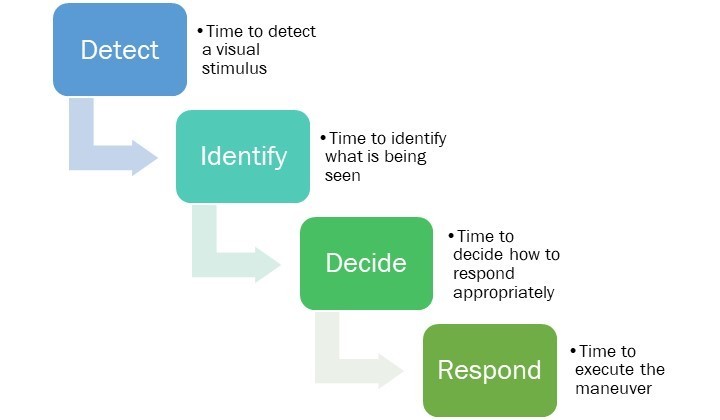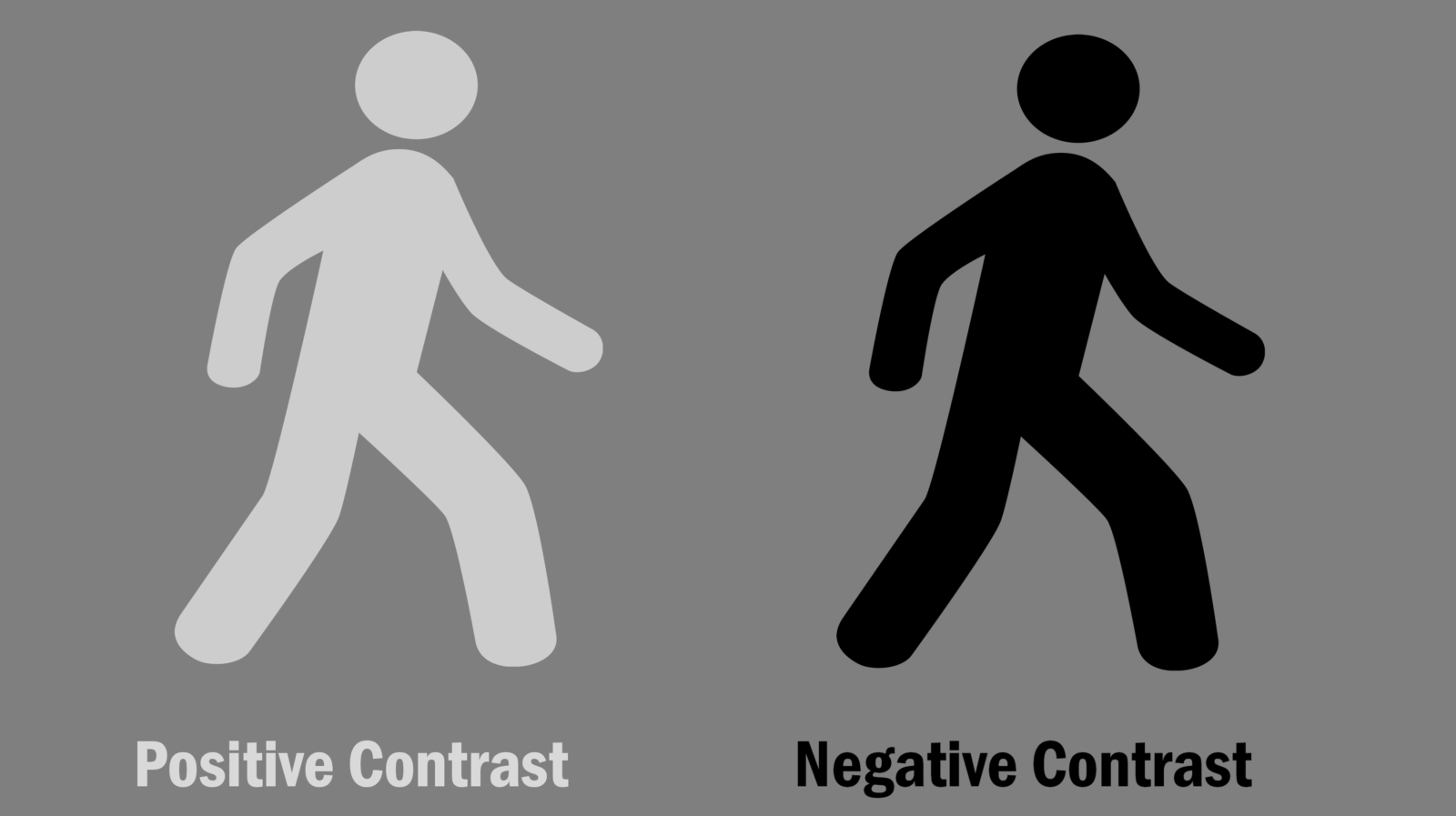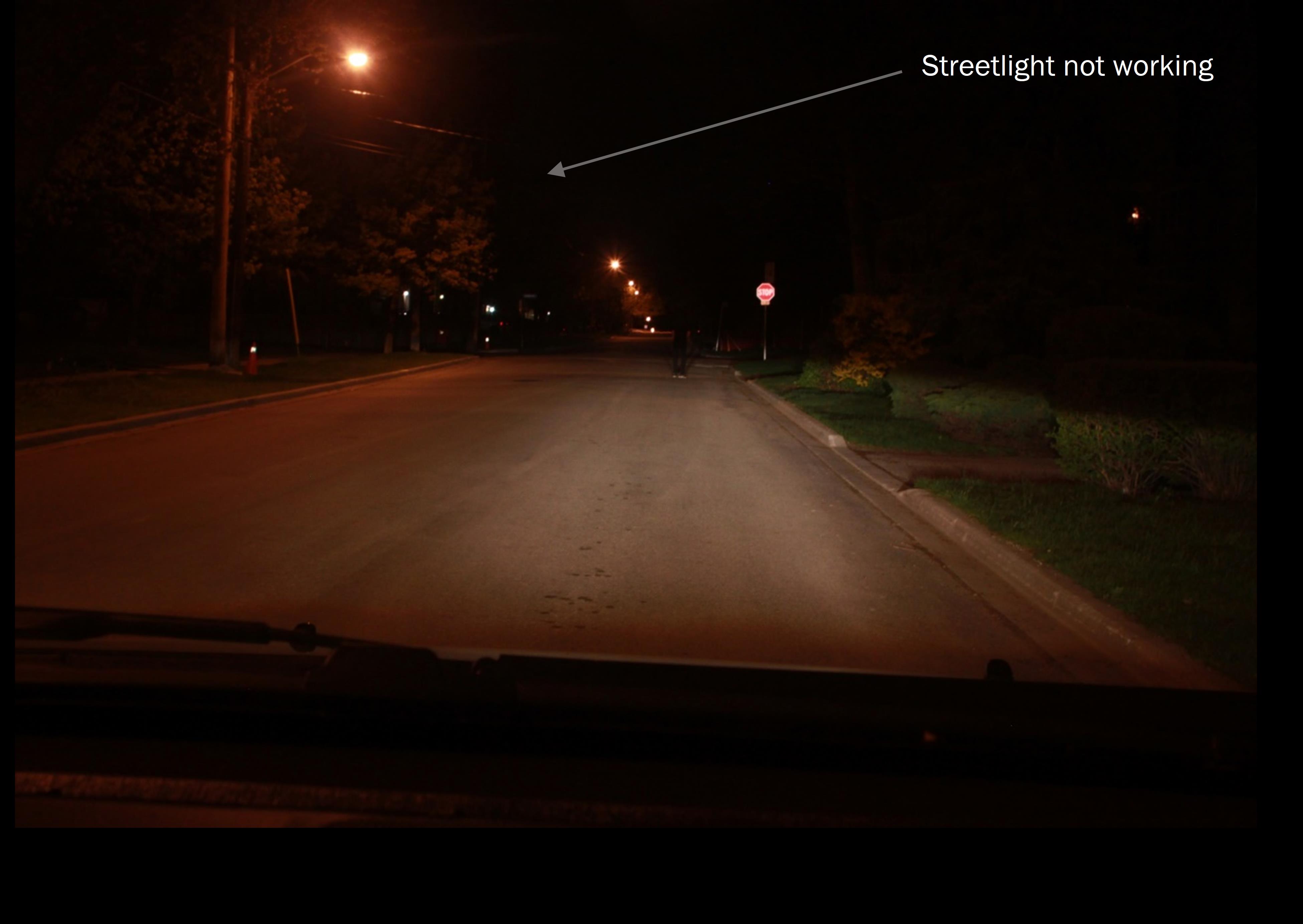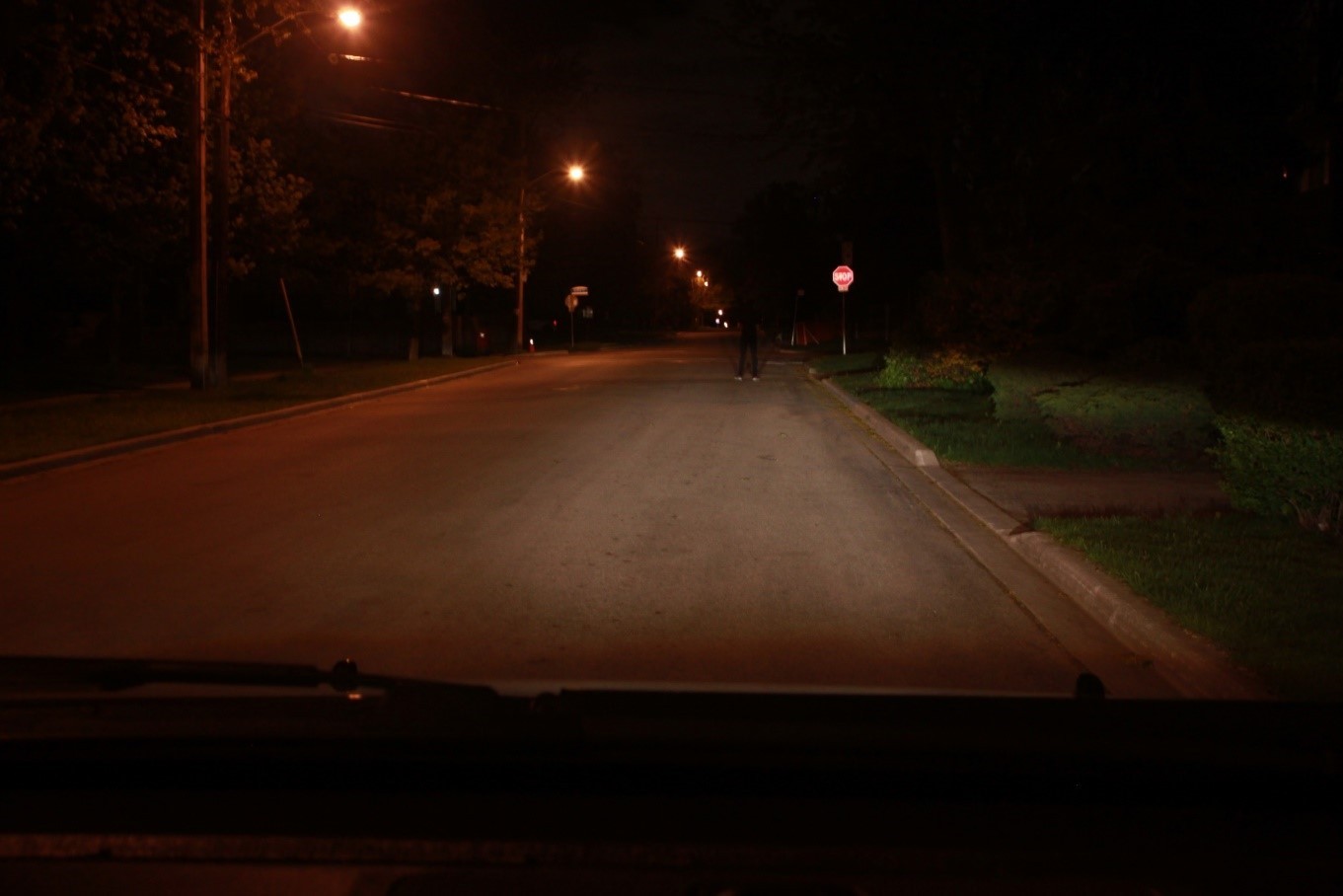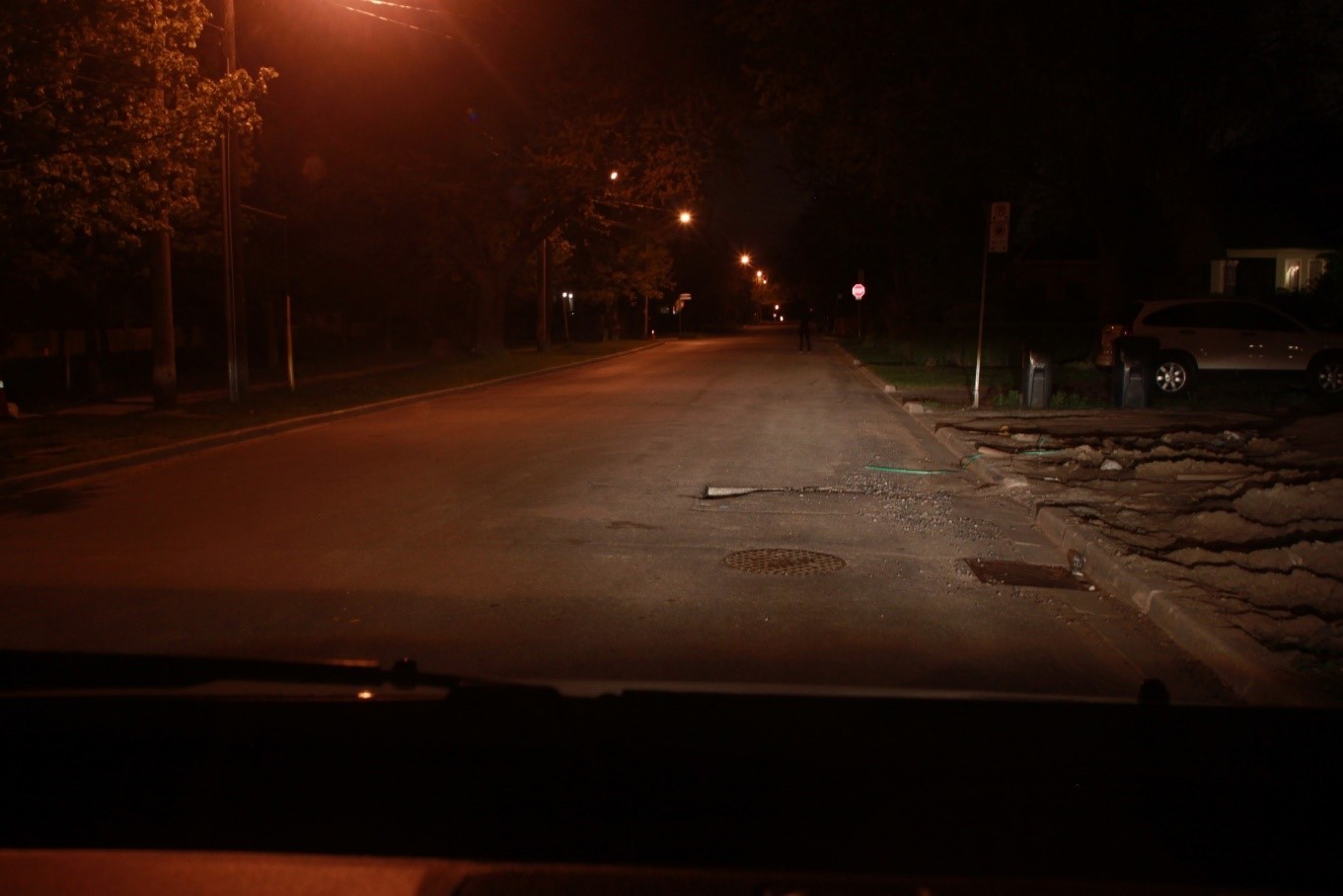Background
This is a tragic case involving a seriously injured 16 year old pedestrian who was riding a longboard (a longer skateboard designed for cruising).
A minivan driver (age 72), moving in the same direction as the pedestrian, collided with the pedestrian at a speed between 45 and 48 km/h. The driver reported not seeing the pedestrian until the collision occurred. The collision occurred at approximately 10:00 PM on a Friday in September on a residential street. The pedestrian was wearing all dark clothes and a dark backpack. The driver was using low-beam headlights, displayed no evidence of any type of impairment, and the minivan was found to be in mechanically sound condition. The streetlight was not working near the location where the pedestrian came to rest after the collision.
Perception-Response Time
A driver needs time to perceive and to take appropriate action to avoid a collision. The perception-response model is illustrated below. The perception-response model illustrates that, rather than the location where the pedestrian came to rest after the collision, it is the seconds leading up to a collision that are critical to understanding the contributing factors to a collision. Based upon the collision reconstruction, the human factors analysis estimated that the driver would have needed at least three seconds of perception-response time for the driver to have avoided the collision (which includes time for braking).
A scaled timeline of the collision is shown below (click to enlarge).
[foogallery id="1087"]
Engineering Expert Witness Opinions
What was the impact of the non-working streetlight on this collision? Could the collision have been avoided if the streetlight had been working?
The engineering expert witnesses came to very different conclusions than the human factors expert witnesses.
The first engineering expert witness provided the following opinion:
This non-functional street light contributed to the lack of roadway lighting in the area. Had the street light been function properly, the driver may have been provided with more opportunity to avoid the collision.
While not shining directly on the area of impact, this malfunctioning streetlight likely contributed to the below-standard lighting level in the area surrounding the area of impact. Further, by reducing the amount of light cast in the area beyond the pedestrian (from the perspective of the driver), the malfunction street light would not have illuminated the background beyond the pedestrian to the same degree, creating less contrast and, therefore, less visibility. Had the street light been functioning and the lighting level met the ANSI standard, the area surrounding the pedestrian may have created more contrast, allowing the driver to detect the pedestrian from even further away, adding to the likelihood of avoidance.
The second engineering expert witness provided a similar opinion:
The absence of identification was likely the result of a lack of illumination of the streetscape and the glare imposed by oncoming traffic. The presence of functioning street lights in the area can be expected to greatly improve the detection distances and significantly reduce the likelihood of collision.
Fixed roadway lighting has been shown to counter the effects of headlight glare. First fixed lighting increases the visibility of pedestrians on the road. Second this lighting raises the adaptation level of the driver, thus mitigating the effects of headlight glare. Since the driver was travelling relatively slowly, but for the non-functioning luminaire, it is probable that the collision would have been avoided.
Both engineering expert witnesses made the argument that if the streetlight had been working then the collision could have been avoided. The engineering expert witnesses opined that if there had been more light then the pedestrian would have been easier to see. The first engineering expert witnesses also has basic understanding of the importance of contrast for detecting pedestrians at night.
Contrast
What is contrast and how does it factor into the ability of drivers to see pedestrians at night?
At night, the driving task depends on a driver’s ability to detect contrast or, in other words, to detect differences between shades of grey. Pedestrians on the road may be detected if they appear lighter than the background. This is known as positive contrast. Pedestrians on the road may be detected if they appear darker than the background. This is known as negative contrast. Positive and negative contrast are illustrated in the figure below. Light may either illuminate an object creating positive contrast, or illuminate the background so that an object may be seen in silhouette which is negative contrast. The detection of positive or negative contrast depends on the driver’s viewpoint and the location of the object relative to streetlights and other sources of light such as vehicle headlights. At night, under normal circumstances a pedestrian in dark, non-reflective clothes can only be seen in negative contrast.
Positive and Negative Contrast
Adapted from Green, M.; Allen, M. J.; Abrams, B.S.; Weintraub, L. Forensic Vision: With Application to Highway Safety. Third Edition. Lawyers & Judges Publishing Company, Inc. 2008. Page 332.
Field Test
What impact do streetlights have on illuminating the background behind a pedestrian to create negative contrast?
The purpose of the field test was to compare viewing conditions with and without a single working streetlight. These photographs were taken at the pedestrian and vehicle positions relative to the streetlights at 3 and 5 seconds before impact.
It is important to note that readers of this post have the luxury of being able to take their time reviewing the photographs from the field visit while a driver would only have seconds to see the scene before impact. In addition, readers of this post are aware of the circumstances of the collision and have an expectation of the presence of someone on the roadway. This expectation that someone is on the roadway greatly reduces the time it takes to find and identify the pedestrian.
In both sets, the top photograph was taken while the streetlight was not working and the bottom photograph was taken after the streetlight had been repaired. The key insight from both of these photographs is that the background behind the pedestrian is dark in both situations. The background is dark when the streetlight is not working and when the streetlight is working. An examination of the paired photos shows that the pavement under the streetlight is better lit when the streetlight is working, However, the pavement under the streetlight is not the background against which the pedestrian is viewed by the driver. In all the photos, the background of the pedestrian above the waist is dark. Below the waist there is some illumination from the streetlights and some from the minivan headlights.
Conclusion
The human factors analysis of the collision takes into account both perception-response time and the importance of contrast.
In conclusion, the dark background makes it difficult to see a dark clad pedestrian. However, the counterargument made by the engineering expert witnesses, that with the streetlight working the background would not be as dark and thus the collision could have been avoided, is false. The background would be dark regardless of whether the streetlight was working or not. This dark background has also been described in the literature as follows:
“The point to this is that, even if the streetlight provides uniform illumination of the roadway and crosswalks, the lighted pavement will not be the background of importance against which the pedestrian will be viewed.”
(Harris, J. L, Sr.; Harris, J. L. II. Forensic Visibility. Lawyers & Judges Publishing Company, Inc. 2012. Page 71.)

